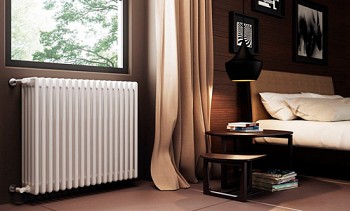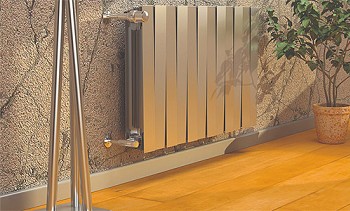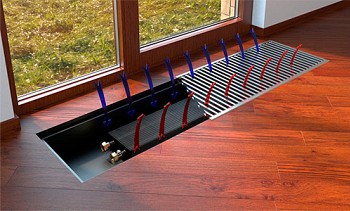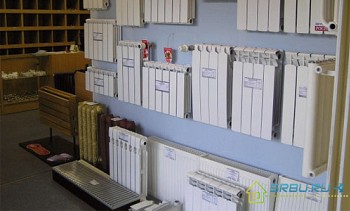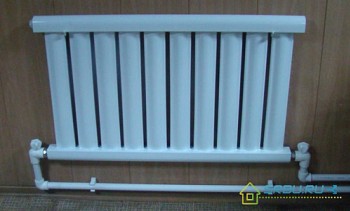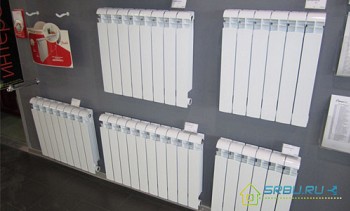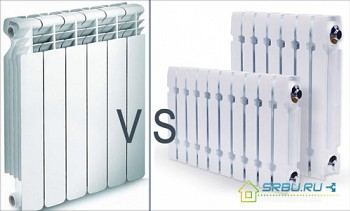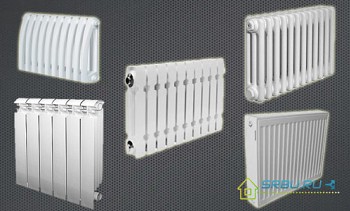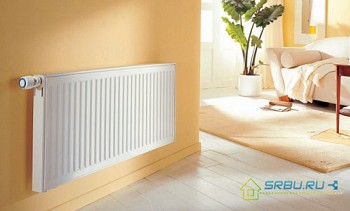When making repairs in an apartment, we often think about replacing old batteries that have expired. It is time to put in their place more modern and efficient devices that have appeared on the market. But here the question arises - which heating radiators are better for an apartment? After all, someone praises aluminum batteries, someone - steel. Some neighbors are not happy with the newfangled bimetallic radiators, while others bought new cast-iron and are also happy. And let's compare these most popular heating appliances, taking into account some of the nuances of centralized heating.
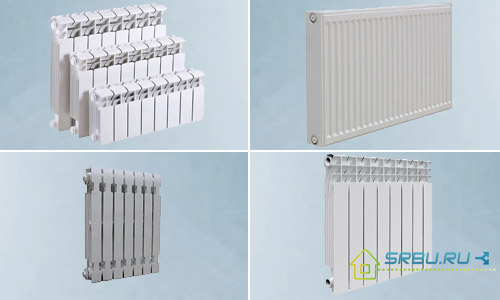
What are the dangers of central heating?
On the one hand, heat supply from the outside is more convenient than autonomous heating - no need to bother with installing the boiler and setting it up. Autumn will come, and hot water will cheerfully run through your batteries, warming the apartment.
But not everything is so smooth in a central heating system:
- The water, which has come a long way, contains many chemically active impurities that can cause corrosion of pipes and radiators.
- And also small particles of sludge, which inevitably fall into the coolant, scratch the batteries from the inside, after a few years rubbing them to holes.
- And the temperature of the water is not always stable - the batteries have room temperature, otherwise it is impossible to touch them.
- And the main danger is a sudden huge jump in pressure in the heating system, the so-called water hammer. It happens, for example, for the reason that the locksmith too abruptly closed the valve of the pumping station.
Previously, valves with smooth running were used there, and with the advent of ball valves, it became possible to shut off water instantly. There is also a water hammer when excess air enters the pipes. A second jump in pressure of ills can do a lot. Weak batteries do not withstand enormous pressure and burst, splashing boiling water, ruining the furnishings and causing damage to the neighbors below.
What parameters to choose radiators for an apartment
Now, knowing the weaknesses of central heating, you can already imagine what requirements good batteries must meet. We list them.
1. For radiators, the pressure declared by the manufacturer must exceed the pressure (both working and one and a half times higher than test pressure) in the heating system. Let’s give an example. In five-story houses of the old layout, this parameter is no more than 5 - 8 atmospheres. High-rise buildings of a modern type are heated under pressure up to 12-15 atmospheres.
2. Separately, we note the ability to withstand water hammer. Because, living in an apartment, it is difficult to protect yourself from pressure surges in heating, it is better to prevent trouble in advance. By the way - if you often hear buzzing and clicking sounds in the batteries, contact the communal service. Pressure, you see, "fools around" in the system.
3. The quality of water in the domestic heating system is unimportant, so the batteries must withstand its “chemical attack” without breaking. It is necessary to use radiators with a special coating on the inside or chemically neutral material for the walls. And their thickness must be such that particles of sand and small pebbles do not rub it, acting like emery.
4. When deciding which radiators are best for an apartment, we will not forget about their main function - to warm. That is, it is preferable to choose devices that have more heat transfer.
5. Let us not ignore the design of radiators - few will be satisfied with ugly cast-iron monsters of poor shape, which were everywhere in Soviet times. I want the batteries to harmoniously complement the decoration of the rooms - today it is quite real.
6. The last parameter is the duration of the service. There are already redundant comments. The less often you have to bother with installing these bulky and rather expensive appliances, the more profitable the owners.
We check which radiators are suitable for apartment heating
Steel batteries - Pali attacked by high pressure
Steel radiators are distinguished by light weight and thickness. Good heat dissipation and a small volume of water make them economical and efficient. Yes, and they are inexpensive. But by pressure they “let us down” - they withstand only 6-8 atmospheres. They are not suitable for apartments, and that’s the point.

Panel steel radiator.

Tubular steel radiator, they have a wide variety and differ both in design and color.
Aluminum radiators - eaten up by corrosion, burst from water hammer
These radiators look pretty, and 190 watts of thermal power pleases the consumer. However, wait, the inhabitants of the apartments - too early to rejoice. Hot water with chemical impurities and high acidity quickly eats up batteries from the inside. After all, aluminum is too active. And he can’t cope with great pressure. The average operating pressure is up to 16 atmospheres. And a water hammer can destroy even a brand new aluminum radiator.

Aluminum radiators have a very attractive appearance and can give off heat simply by heating the air or convection, but are absolutely not suitable for an apartment.
Bimetal batteries - everyone is good, only roads
This is one of the newest developments of heating appliances. Such radiators are called bimetallic - because they have two metals. This may be, in particular, aluminum and steel, or aluminum and copper.

A ribbed figured body is made of aluminum alloy, and inside is a core made of steel or copper.
Manufacturers guarantee that they will last for at least forty years. For an apartment, they are suitable for all indicators, as you can see.
- They withstand temperatures even up to 130 degrees.
- They have a working pressure of up to 30 - 50 atmospheres, depending on the manufacturer and model. With them, you can stop being afraid of water hammer.
- Corrosion-resistant external and internal primers make batteries durable and resistant to destruction.
- Light weight makes installation, carrying and transportation of such batteries easy.

The look pleasantly caresses their eyes - beautiful white or colored panels are much more aesthetically pleasing than the usual form of a cast-iron “accordion”.
Alas - not everyone can buy such an expensive device. And if you are offered something like that at a reasonable price - do not believe it. Fake a slip. If you buy, then the products of trusted brands - the Russian company Rifar, Italian - Sira or Global. There are good Chinese manufacturers. They, like the Russians, have a slightly lower price than radiators originally from Europe.
Good old cast iron - gains a second life
About fifty years, no less, it is measured to live such a battery. Some manufacturers of new products claim in vain that it is high time to forget about this “old stuff”. Thinking long about which heating radiators to choose for an apartment, many stop on cast-iron batteries. They will not “throw out tricks” upon contact with dirty domestic water in the heating system. This metal is chemically passive, and it is not afraid of either high acidity or the presence of chemical additives in the coolant. And thick walls will not hurt any abrasive. So, cast iron for an apartment (especially in an old house) is very good.
- Cast iron radiators are distinguished by the fact that they hold heat for a very long time - the residual number of its storage is 30 percent. And for all other types of batteries, this figure is half
- Heat transfer due to the radiation method of heating is much more effective than when using convection (as in bimetallic and aluminum products. Cast-iron radiators heat not only air, but also nearby objects.
- When draining water from the system in the summer, cast-iron batteries do not rust - this is a significant plus.
- A large heat transfer area is another plus.
- The pressure drops that central heating sins, cast iron usually tolerates well. Up to nine to twelve atmospheres can reach working pressure. It’s just that it does not always withstand hydroblows of high power - it brings the fragility of this metal.
- The cost of these devices is usually lower than that of bimetallic radiators. Sometimes this is a determining factor.
These radiators are heavy, of course, which causes some inconvenience during their installation. Well, yes, cast iron a priori can not be easy. But after all, this weight turns into a large wall thickness, giving radiators the necessary strength. By putting cast-iron radiators once (and specially trained people - plumbers will do this), you can forget about replacing them for many years.
The appearance of cast-iron radiators is no longer as poor as it was during the Soviet era. Appeared very attractive externally shaped batteries, made in the style of "retro", which are in good harmony with the exquisite rooms. For example, mention may be made of products from Roca and Konner.
True, the cost of such miracle batteries is quite high. More budgetary are Ukrainian, Russian and Belarusian models, many of which must be painted before use. But they look quite worthy, their design fits into the interiors of modern apartments.
In conclusion, we draw conclusions
Now it’s probably easier for you to decide which radiator to choose for the apartment - because of the four options considered, only two remain. As it turned out, neither steel nor aluminum radiators tested either by aggressive domestic coolant, or by pressure drops, will not stand. So, there are bimetallic and cast-iron appliances. What exactly to buy, look at your budget, as well as the characteristics of specific models. However, here you can give a couple of tips.
- In old houses (for example, "Khrushchev") it is quite possible to put cast-iron products. If you live in a high-rise building, where the pressure of the heating system is higher, it is better to take bimetallic radiators.
- If the predecessors of your future new batteries are made of cast iron, then you can opt for either of two options. Both bimetal and cast iron will do. If you are going to replace batteries made of another metal, then replace them only with bimetallic ones.
Video: Replacing heating radiators in an apartment

